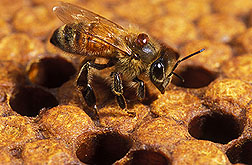This page has been archived and is being provided for reference purposes only. The page is no longer being updated, and therefore, links on the page may be invalid.
|
See our information kit to find out more. |
||
|
|
||
|
|
Honey Bees Selected by ARS Toss Out Varroa Mites
By Alfredo FloresSeptember 10, 2009
Honey bees are now fighting back aggressively against Varroa mites, thanks to Agricultural Research Service (ARS) efforts to develop bees with a genetic trait that allows them to more easily find the mites and toss them out of the broodnest.
The parasitic Varroa mite attacks the honey bee, Apis mellifera L., by feeding on its hemolymph, which is the combination of blood and fluid inside a bee. Colonies can be weakened or killed, depending on the severity of the infestation. Most colonies eventually die from varroa infestation if left untreated.
Varroa-sensitive hygiene (VSH) is a genetic trait of the honey bee that allows it to remove mite-infested pupae from the capped brood—developing bees that are sealed inside cells of the comb with a protective layer of wax. The mites are sometimes difficult for the bees to locate, since they attack the bee brood while these developing bees are inside the capped cells.
ARS scientists at the agency’s Honey Bee Breeding, Genetics and Physiology Research Unit in Baton Rouge, La., have developed honey bees with high expression of the VSH trait. Honey bees are naturally hygienic, and they often remove diseased brood from their nests. VSH is a specific form of nest cleaning focused on removing varroa-infested pupae. The VSH honey bees are quite aggressive in their pursuit of the mites. The bees gang up, chew and cut through the cap, lift out the infected brood and their mites, and discard them from the broodnest.
See this activity in the attached video link here:
This hygiene kills the frail mite offspring, which greatly reduces the lifetime reproductive output of the mother mite. The mother mite may survive the ordeal and try to reproduce in brood again, only to undergo similar treatment by the bees.
To test the varroa resistance of VSH bees, the Baton Rouge team conducted field trials using 40 colonies with varying levels of VSH. Mite population growth was significantly lower in VSH and hybrid colonies than in bee colonies without VSH. Hybrid colonies had half the VSH genes normally found in pure VSH bees, but they still retained significant varroa resistance. Simpler ways for bee breeders to measure VSH behavior in colonies were also developed in this study.
This research was published in the Journal of Apicultural Research and Bee World.
ARS is the U.S. Department of Agriculture’s chief intramural scientific research agency.

